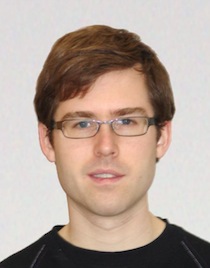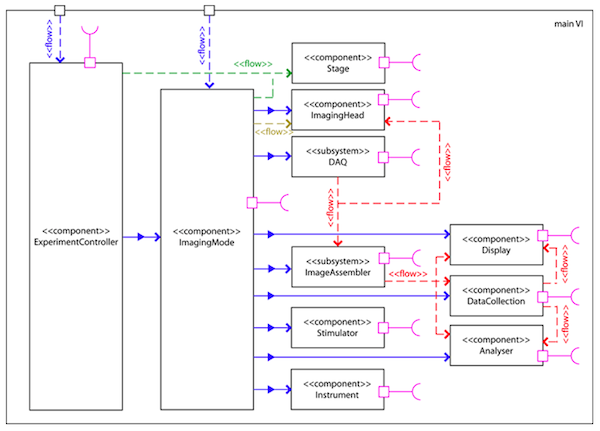Interview with the developers of HelioScan

Last Monday, Labrigger covered HelioScan, a LabVIEW-based, two-photon laser scanning microscopy software suite.


Marcel van ‘t Hoff (left) and Dominik Langer (right) are the two main developers of HelioScan. They were kind enough to answer some interview questions for Labrigger.
LR: Are there special considerations you had to make when designing HelioScan? What measures did you take in LabVIEW to support the level of modularity?
The main design considerations were to design for future flexibility and for multiple developers to easily collaborate without interfering. The idea was then to assemble the software at run-time from components that are dynamically loaded based on configuration settings. LabVIEW classes are the ideal candidates for such components:
First, they naturally bundle data and corresponding VIs into separate entities.
Second, LabVIEW allows to load and instance classes at run-time based on the class file path (which can be specified in a configuration file).
Third, using class inheritance and polymorphy, we can substitute any two components, as long as interacting other classes refer to them in terms of the same abstract base class. For example, a particular ScanHead component can handle any incoming Trajectory component as long it is a subclass of a particular expected abstract base class.
Fourth, by means of aggregation combined with the above principles, we can build up highly complex objects at run time.
An example: HelioScan may read from its main configuration file to load a particular ImagingMode. During its initialization, the loaded ImagingMode object reads its own configuration file, stating that – among other components – a particular ScanHead component is to be loaded. Once loaded, the ScanHead object reads a configuration guiding it to load a bunch of Scanner components of a particular type, etc.
A couple of others have implemented individual components, demonstrating that the distributed multideveloper scenario is working.

LR: In the near future, say 5 years, who will be maintaining the core HelioScan codebase and leading new developments?
We are currently in a transition phase. First, both Marcel and I just left Fritjof Helmchen’s lab. While Marcel is going to continue as a postdoc in the field and will still use HelioScan, I will leave the academic field. Second, we are currently working on a major new version of HelioScan that we expect to bring about another quantum leap in flexibility. The new version will be based on a framework for distributed cross-platform signal processing (Murmex) that we are developing. We have been developing this framework in our free time and plan to continue doing so. Murmex as the new core will allow HelioScan components to be written not only in LabVIEW, but various other well-known programming languages. We believe that this will lower the entry barrier for new developers enough for HelioScan to become a project that can be handed over to the community. New components will be collected on a central repository, given that they meet some basic quality standards. This will be similar to certain ImageJ distributions, such as FIJI.
LR: Do you have design principles that you follow to ensure that your LabVIEW programs don’t become spaghetti?
First, we try to stick as far as possible the style rules from “The LabVIEW Style Book” (Peter A. Blume, Prentice Hall) [Also covered here. -Labrigger]. That’s also the book we usually recommend to newcomers before they start to develop their own components.
Second, HelioScan is implemented using LabVIEW object-oriented programming (LVOOP), which naturally already structures the code by bundling related data and functionality into LabVIEW classes.
Third, we made very good experiences with the so-called XControls of LabVIEW. XControls are your own, re-usable user interface controls, which can provide arbitrarily complex functionality. For example, we made an XControl that allows to load and display multi-page TIFF files, where the user can scroll through the frames, draw different types of ROIs, load and save ROI seletions, and display file meta-information. On the VI block diagram, this whole functionality is represented by a single terminal, hiding all the underlying complexity from the developer.
Fourth, we heavily use a couple of design patterns to do certain things.
Fifth, the HelioScan framework enforces a lot of structure. When we develop a new component, we subclass an abstract class of the framework and override some of its methods. For example, when we need a new scan pattern for galvanometric mirrors, we subclass a generic Trajectory class. We override (among others) the initialise method of the class and put the code initialising the pattern exactly there (and nowhere else).
LR: Were there any issues with getting Subversion to support LabVIEW? In practice, do you use the graphical diff view?
We actually switched to Git in the meantime and have a repository hosted on github.com. Github also provides our issue tracking system. We don’t use any special integration with LabVIEW. Rather, we rely on the following two rules:
1. Each developer only works (and commits) on the component he owns. Frequent commits with good log messages are mandatory. If a developer wants to make changes on a component he doesn’t own, he asks for permission and releases the component again when he is done (either by talking to the owner or by email).
2. Changes at the framework level (this concerns the HelioScan main VI as well as all the abstract classes) are taboo for anybody but Marcel and me. Such changes have to be well-planned and orchestrated because their consequences may affect any other component and already running systems.
LR: Seeing as FPGA support is built into HelioScan, will example AOD packages or other application examples be released?
The newest release of HelioScan supports AOD-based scanning in frame scanning and random-access point scanning mode. In both cases, both generation of scan signals as well as integration of PMT signals is performed on the FPGA. It is important to note, however, that we rely on a particular FPGA card from National Instruments in conjunction with a particular digital synthesizer board and analog-to-digital converter. For other hardware, particular components would have to be adapted.
Also in resonant-scanner-based modes, we use the FPGA to calculate scan signals for the the y-scanner and a fast z-focusing device used in volume scanning.
For galvo-based modes on contrast, scan-signals are pre-calculated on the host PC, while PMT come in either through an FPGA-based system or a traditional DAQ card. The user is free to choose.
LR: Has HelioScan been modified to simultaneously control electrophysiological recordings? Or is that typically handled by a separate, but synchronized system?
No, there is no particular support for electrophysiology recordings. There is the possibility to read in electrophysiology signals through one of the PMT channels, though. However, the usual approach is rather to use the shutter control output of HelioScan to trigger some other software (HelioScan as master, e-phys software as slave). An alternative solution is to use an external TTL signal (either from the e-phys software or some other souce) to trigger HelioScan image acquisition (HelioScan as slave).
Does HS enable data analysis? Standard programmes (best e.g. imageJ) require standard confocal scanning.
When one leaves the normal x-y-z pixel acquisition one becomes “stuck”.
The arbitrary scanning Helmchen developed is cool, but without a useful data analysis package, impossible to use.
[…] Here’s a Labrigger interview with the developers. […]